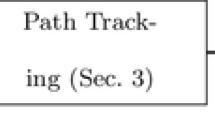Abstract
Conventional solutions to control design problems in complex space missions are often based on a solution of an associated optimal control problem. Due to limited onboard computing capacity, the computation of an optimal trajectory and a dedicated controller are commonly carried out offline, in advance of a mission. This approach requires the definition of a nominal set of initial conditions and system parameters, which are generally different from the conditions during the actual manoeuvre. This paper proposes an approach based on multivariate spline interpolation for generating nearly optimal solutions online, despite the difference between the nominal and actual conditions during the manoeuvre. The onboard computations are limited to simple interpolations and hence do not cause considerable additional computing effort. Compared to conventional control design approaches, the proposed method significantly increases the region of initial conditions and size of parametric uncertainties for which the manoeuvre can be successfully completed. The applicability and practical relevance of this approach are demonstrated for a Moon landing manoeuvre.








Similar content being viewed by others
Notes
For \(x<a\) (\(x>b\)) use the first (last) \(k\) B-splines.
As the main thrust must be piecewise constant, the approximated main thrust is determined by interpolation between the switching times.
To better compare the results, the “downrange shifting approach” introduced in [7] is deactivated here.
In fairness, the cubic interpolation methods are not tested here, because three optimal solutions in both directions are not enough to achieve better results than linear interpolation.
All computations were performed on a personal computer with Dual Core CPU E6700 @3.20 GHz.
References
Lockner, E.: Echtzeitfähige Trajektorien-Synthese mittels multivariater Interpolationsverfahren am Beispiel eines Mondlandemanövers. Diploma thesis, University of Bremen (2011)
Saraf, A., Leavitt, J.A., Mease, K.D., Ferch, M.: Landing footprint computation for entry vehicles. In: AIAA Guidance, Navigation and Control Conference and Exhibit, Providence, Rhode Island (2004)
Liu, C., Atkeson, C.G.: Standing balance control using a trajectory library. In: The 2009 IEEE/RSJ International Conference on Intelligent Robots and Systems, St. Louis (2009)
de Boor, C.: A Practical Guide to Splines. Springer, New York (2001)
Lyche, T., Morken, K.: Spline Methods. Department of Informatics, University of Oslo (2011). http://www.uio.no/studier/emner/matnat/ifi/INF-MAT5340/v11/undervisningsmateriale/book.pdf
Knauer, M.: Fast and save container cranes as bilevel optimal control problems. In: Mathematical and Computer Modelling of Dynamical Systems. Taylor and Francis, London (2011)
Oehlschlägel, T., Theil, S., Krüger, H., Knauer, M., Tietjen, J., Büskens, C.: Optimal guidance and control of lunar landers with non-throttable main engine. In: Holzapfel, F., Theil, S. (eds.) Advances in Aerospace Guidance. Navigation and Control, pp. 451–463. Springer, Berlin (2011)
Knauer, M., Büskens, C.: From WORHP to TransWORHP. In: Proceedings of the 5th International Conference on Astrodynamics Tools and Techniques, Noordwijk (2012)
Büskens, C., Maurer, H.: SQP-methods for solving optimal control problems with control and state constraints: adjoint variables, sensitivity analysis and real-time control. J. Comput. Appl. Math. 120(1–2), 85–108 (2000)
Author information
Authors and Affiliations
Corresponding author
Additional information
This paper is based on a presentation at the German Aerospace Congress, September 10–12, 2012, Berlin, Germany.
Rights and permissions
About this article
Cite this article
Lockner, E., Oehlschlägel, T., Theil, S. et al. Real-time capable trajectory synthesis via multivariate interpolation methods for a moon landing manoeuvre. CEAS Space J 6, 107–118 (2014). https://doi.org/10.1007/s12567-014-0063-z
Received:
Revised:
Accepted:
Published:
Issue Date:
DOI: https://doi.org/10.1007/s12567-014-0063-z




